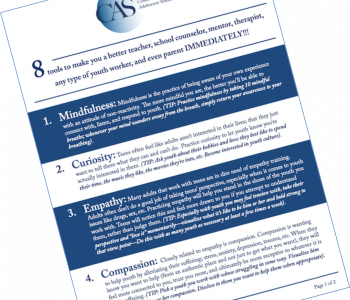

Catharine Hannay, MA
Catharine Hannay is the founder of MindfulTeachers.org and the author of Being You: A Girl’s Guide to Mindfulness, a workbook for teen girls on mindfulness, compassion, and self-acceptance.
5 Types of Boundaries Every Youth Worker Needs
Here are a few guidelines for establishing appropriate boundaries with the youth under your care.
Boundary #1
Your Personal Information
In one of my very first sessions teaching English as a Second Language, I was helping students fill out forms. During the break, my supervisor pulled me aside and explained why it wasn’t such a great idea to write my own home address and phone number on the blackboard. At least I didn’t go as far as one of my co-teachers—in a lesson on money and banking, he used a copy of his own credit card!
Fortunately, none of our students took advantage of us, but we were awfully naive.
Think carefully about how much personal information you share with your students or clients, including:
how much you say about your family;
which photos you display in your workspace; and
what you share on social media.
The decisions you make about these issues will depend partly on your own comfort level and partly on the nature of your job—for example, there are obvious differences between working in the criminal justice system vs. working as a youth pastor in a small town where you’ve known all the families for many years.
Boundary #2:
Your Time
To the extent that you have control over your schedule…
Think about what you might be willing to do in an occasional emergency vs. what you can sustain on a daily or weekly basis.
This includes:
hours at your workplace,
bringing work home, and
responding to messages during your time off.
If you’re clear about when you are and aren’t available, it’s much less likely to be interpreted as a rejection if you tell one of the youth that you can’t see them on any particular day.
To convey that you care about them but have other commitments, you could say something like:
“I’m glad I could give you some extra help yesterday. Today there’s somebody else who really needs my help, so I’d like to give him a turn. Are you free after school on Thursday?”
OR
“I need to meet with another client right now. Let’s talk more about this when I see you next week.”
OR
“I never schedule appointments on the weekends because that’s when I spend time with my family.”
Boundary #3:
Your Rules or Policies
It’s important to establish clear, consistent policies about what you will and won’t accept from the youth. It’s much easier if you make the rules clear from the beginning, rather than trying to enforce something after you’ve let it slide a couple of times.
However, it’s equally important to make reasonable exceptions for serious illness or other emergency, and to make a distinction between high spirits and behavior that’s actually harmful.
If you’re like me, you might find it challenging to be firm enough rather than too much of a pushover.
Or, if you have a more forceful personality, you might have trouble knowing when to ease up.
Think about where you might need a brick wall and where you might just need an invisible fence or a line in the sand.
Boundary #4:
Your Professional Role
It goes without saying that you should follow the ethical guidelines of your profession and not do anything that’s obviously harmful to youth. There are also some situations that might seem beneficial at first but that actually cause unintended harm.
If the kids see you as their buddy, it can lead to hard feelings later on when you need to give a bad grade or enforce a limit as the adult in charge. You could also run into problems with your supervisor or coworkers.
Several years ago, I worked with a teacher who acted like one of the youth, socializing with them after school and on the weekends, and texting them at all hours of the day and night.
She was very popular with the students, but she wasn’t viewed well by our boss or colleagues. Her opinion was ignored during faculty meetings, and she was passed over for a promotion in favor of someone who was less qualified.
For the record, I liked her a lot and thought she was treated unfairly—but she wasn’t doing herself any favors when she ran through the office giving piggyback rides.
It’s also important not to be seen as too much of an ally against fellow adults. For example, one of my high school teachers bailed a couple of kids out of jail so they could (at least temporarily) hide from their parents that they’d been arrested.
In his book Trauma-Informed Mindfulness with Teens, Dr. Sam Himelstein mentions an even more extreme example: A case manager agreed to hide a client’s gun so it wouldn’t be found by his probation officer.
“While that youth thought he was the ‘coolest in the world,’ the case manager also shifted from being a safe, caring, and boundaried adult (i.e., a supporter) to someone who the youth could rely on to continue his illegal activities (i.e., a colluder).
Although the client liked him, he didn’t truly respect or feel safe with the case manager. Instead, it became yet another relationship with an adult that was unhealthy and transactional (i.e., you do something for me; I do something for you, even if it is illegal).
This is a sharp contrast to the type of delicate trust needed for multiply traumatized youth to feel safe enough to delve into their life experiences in a counseling session.
Boundary #5:
Your Heart and Mind
The more you care about the youth and about doing a good job, the more challenging it can be to take any time mentally away from your work. I used to lie awake for hours ruminating about school, then dream about my students!
As Eric Maisel says, “Perhaps our next brain model will come with an off switch […], but for now, the only off switch we have is smart inner conversation.” (Why Smart People Hurt: p. 52)
These days, whenever I need to interrupt a worry loop, I remind myself:
“This isn’t helping right now.”
“I’ve already thought through this situation as much as I can.”
“I’ll be in a better position to help if I can get some rest.”
“At the beginning of my career, I had trouble leaving my clients’ pain at the office. I had to be equally dragged down by it or it meant I was ‘insensitive’ and ‘didn’t care.’ […] It was absolutely unsustainable.”
Psychotherapist Whitney Goodman, Toxic Positivity, p. 205-206
Not taking on the burden of your students’ or clients’ suffering doesn’t mean you aren’t concerned about them. It means you’re in a much better position to keep helping long-term. (See: “Three Tips for Managing Compassion Fatigue and Empathic Distress.”)
Conclusion
Establishing appropriate boundaries can help you focus on your own personal well-being while also doing what’s in the best interests of your students, patients, or clients.
Join the FREE Resilience Community for Helping Professionals to learn more about mindfulness, resilience, trauma-informed care, building relationships, and more! Our community features self-paced courses, a monthly live Zoom call, a weekly live meditation, and an online platform to connect with other providers/professionals in your field.
Related Posts
Four Dos and Don’ts for Setting Effective Boundaries with Youth
4 Simple Tips for Creating Safety with Group Agreements
What Can I Do if a Youth Asks Me for Personal Information?
Why Setting Boundaries is Critical to Healthy Relationships with Teens

